Dragging Core2Duo into 2013: Time for an Upgrade?
by Ian Cutress on January 15, 2013 12:30 PM EST- Posted in
- CPUs
As any ‘family source of computer information’ will testify, every so often a family member will want an upgrade. Over the final few months of 2012, I did this with my brother’s machine, fitting him out with a Sandy Bridge CPU, an SSD and a good GPU to tackle the newly released Borderlands 2 with, all for free. The only problem he really had up until that point was a dismal FPS in RuneScape.
The system he had been using for the two years previous was an old hand-me-down I had sold him – a Core2Duo E6400 with 2x2 GB of DDR2-800 and a pair of Radeon HD4670s in Crossfire. While he loves his new system with double the cores, a better GPU and an SSD, I wondered how much of an upgrade it had really been.
I have gone through many upgrade philosophies over the decade. My current one to friends and family that ask about upgrades is that if they are happy installing new components. then upgrade each component to one of the best in its class one at a time, rather than at an overall mediocre setup, as much as budget allows. This tends towards outfitting a system with a great SSD, then a GPU, PSU, and finally a motherboard/CPU/memory upgrade with one of those being great. Over time the other two of that trio also get upgraded, and the cycle repeats. Old parts are sold and some cost is recouped in the process, but at least some of the hardware is always on the cutting edge, rather than a middling computer shop off-the-shelf system that could be full of bloatware and dust.
As a result of upgrading my brother's computer, I ended up with his old CPU/motherboard/memory combo, full of dust, sitting on top of one of my many piles of boxes. I decided to pick it up and run the system with a top range GPU and an SSD through my normal benchmarking suite to see how it faired to the likes of the latest FM2 Trinity and Intel offerings, both at stock and with a reasonable overclock. Certain results piqued my interest, but as for normal web browsing and such it still feels as tight as a drum.
The test setup is as follows:
Core2Duo E6400 – 2 cores, 2.13 GHz stock
2x2 GB OCZ DDR2 PC8500 5-6-6
MSI i975X Platinum PowerUp Edition (supports up to PCIe 1.1)
Windows 7 64-bit
AMD Catalyst 12.3 + NVIDIA 296.10 WHQL (for consistency between older results)
My recent testing procedure in motherboard reviews pairs the motherboard with an SSD and a HD7970/GTX580, and given my upgrading philosophy above, I went with these for comparable results. The other systems in the results used DDR3 memory in the range of 1600 C9 for the i3-3225 to 2400 C9 for the i7-3770K.
The Core2Duo system was tested at stock (2.13 GHz and DDR2-533 5-5-5) and with a mild overclock (2.8 GHz and DDR2-700 5-5-6).
Gaming Benchmarks
Games were tested at 2560x1440 (another ‘throw money at a single upgrade at a time’ possibility) with all the eye candy turned up, and results were taken as the average of four runs.
Metro2033
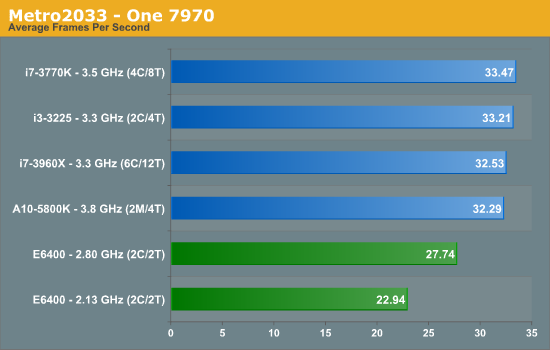
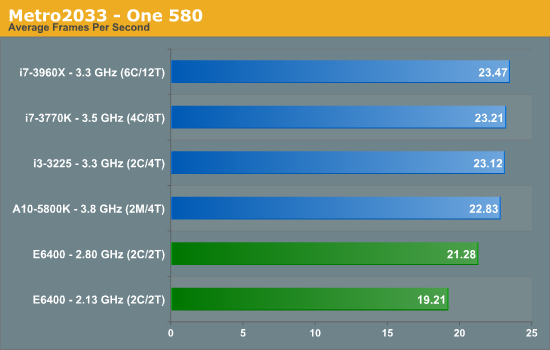
While an admirable effort by the E6400, and overclocking helps a little, the newer systems get that edge. Interestingly the difference is not that much, with an overclocked E6400 being within 1 FPS of an A10-5800K at this resolution and settings while using a 580.
Dirt3
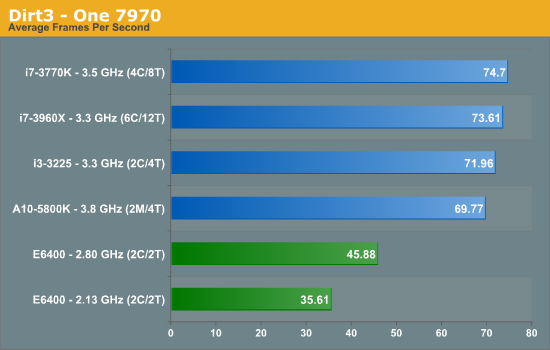

The bump by the overclock makes Dirt3 more playable, but it still lags behind the newer systems.
Computational Benchmarks
3D Movement Algorithm Test
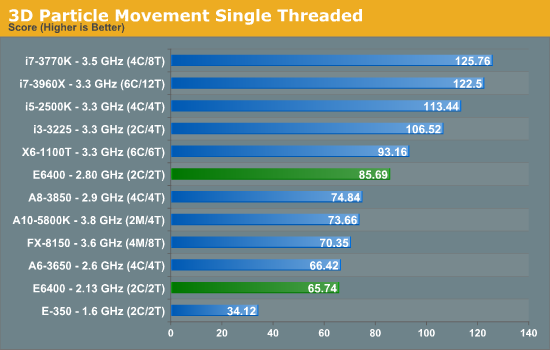
This is where it starts to get interesting. At stock the E6400 lags at the bottom but within reach of an FX-8150 4.2 GHz , but with an overclock the E6400 at 2.8 GHz easily beats the Trinity-based A10-5800K at 4.2 GHz. Part of this can be attributed to the way the Bulldozer/Piledriver CPUs deal with floating point calculations, but it is incredible that a July 2006 processor can beat an October 2012 model. One could argue that a mild bump on the A10-5800K would put it over the edge, but in our overclocking of that chip anything above 4.5 GHz was quite tough (we perhaps got a bad sample to OC).
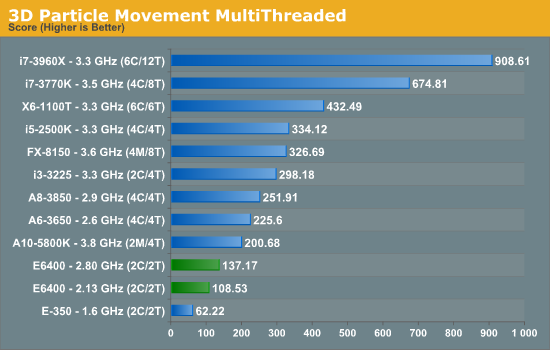
Of course the situation changes when we hit the multithreaded benchmark, with the two cores of the E6400 holding it back. However, if we were using a quad core Q6600, stock CPU performance would be on par with the A10-5800K in an FP workload, although the Q6600 would have four FP units to calculate with and the A10-5800K only has two (as well as the iGPU).
WinRAR x64 3.93 - link

In a variable threaded workload, the DDR2 equipped E6400 is easily outpaced by any modern processor using DDR3.
FastStone Image Viewer 4.2 - link
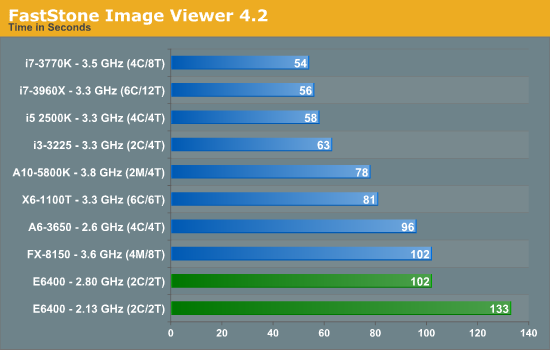
Despite FastStone being single threaded, the increased IPC of the later generations usually brings home the bacon - the only difference being the Bulldozer based FX-8150, which is on par with the E6400.
Xilisoft Video Converter
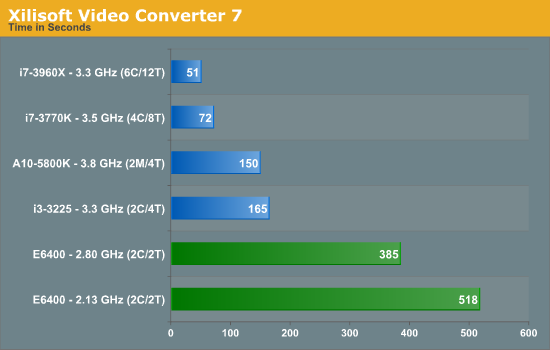
Similarly with XVC, more threads and INT workloads win the day.
x264 HD Benchmark
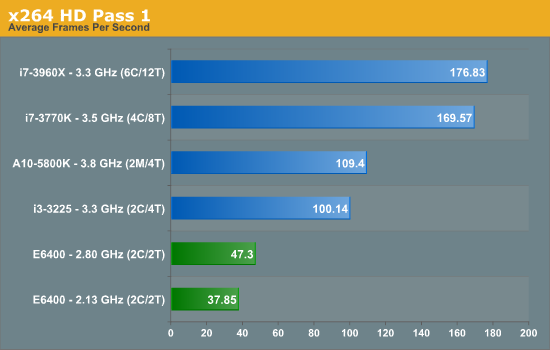
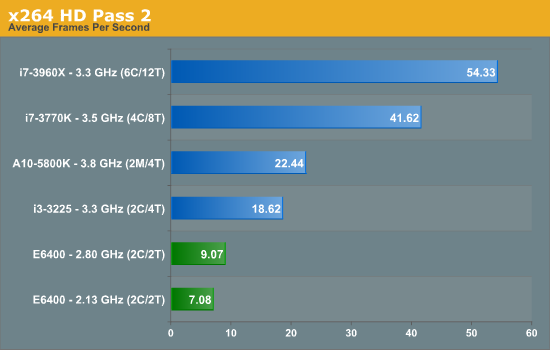
Conclusions
When I start a test session like this, my first test is usually 3DPM in single thread mode. When I got that startling result, I clearly had to dig deeper, but the conclusion produced by the rest of the results is clear. In terms of actual throughput benchmarks, the E6400 is comparatively slow to all the modern home computer processors, either limited by cores or by memory.
This was going to be obvious from the start.
In the sole benchmark which does not rely on memory or thread scheduling and is purely floating point based the E6400 gives a surprise result, but nothing more. In our limited gaming tests the E6400 copes well at 2560x1440, with that slight overclock making Dirt3 more playable.
But the end result is that if everything else is upgraded, and the performance boost is cost effective, even a move to an i3-3225 or A10-5800K will yield real world tangible benefits, alongside all the modern advances in motherboard features (USB 3.0, SATA 6 Gbps, mSATA, Thunderbolt, UEFI, PCIe 2.0/3.0, Audio, Network). There are also significant power savings to be had with modern architectures.
My brother enjoys playing his games at a more reasonable frame rate now, and he says normal usage has sped up by a bit, making watching video streams a little smoother if anything. The only question is where Haswell will come in to this, and is a question I look forward to answering.


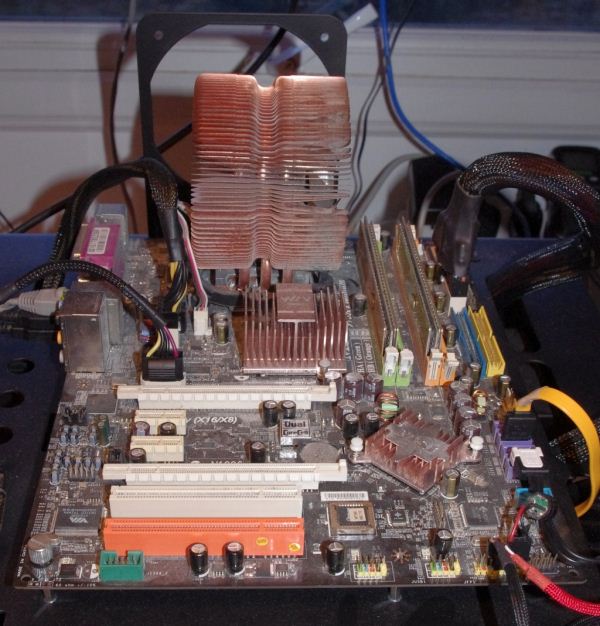








136 Comments
View All Comments
themossie - Wednesday, January 16, 2013 - link
Agreed... unless you need the processor speed for work, who cares if it takes 3-4x the time to transcode or unpack a file?Heck, I run transcoding in a VM on a seperate SSD, restricted to ~25-50% CPU utilization, so I can keep my system responsive during long encodes.
This may be an extreme case - I have a slow machine (Core 2 Duo / Phenom II X4, see my post several comments down) and don't need that file encoded (or unpacked) this very second.
But if you need the video now... why not just watch it directly?
themossie - Wednesday, January 16, 2013 - link
Also, is unpacking RARs really CPU-limited? It's always been storage limited for me. 7zip seems to write the RAR as it unpacks it into a temporary file, then copy it and delete the temp file - 2x the optimal disk writes. Any more efficient and equally functional ZIP/RAR software?Loki726 - Wednesday, January 16, 2013 - link
I used to think this as well but you may be surprised if you benchmark it. The suffix sort in the BWT used by bzip2 and the markov chain predictors used in LZMA 7zip are actually quite slow and even a high end CPU may be slower than disk. This is especially true (for compression) if you get a good compression ratio since you end up writing that much less data to disk.themossie - Thursday, January 17, 2013 - link
Will look that up, thank you!Alucard291 - Friday, January 18, 2013 - link
And this is true. But in the scope of the review above "for most people" (I know that's too general) how big is the rar they open going to be?1gb tops? If its some stolen game. In reality usually even less. So say its some rar with some photos or some random songs? 200mb? takes what? 10 seconds to unpack? with c2d it would take 20. Oh The Horror.
lyeoh - Wednesday, January 16, 2013 - link
7zip only uses temp files if you drag and drop, this appears to be because of the way windows explorer does things: http://www.7-zip.org/faq.htmlhttp://superuser.com/questions/302116/what-is-the-...
themossie - Thursday, January 17, 2013 - link
Thanks for the information, that would make sense!However, I have used other compression software that doesn't have this issue with drag and drop (most recently, PeaZip - don't use it now as the interface doesn't work well for me) so I'm not sure I trust their explanation of it :-)
Death666Angel - Wednesday, January 16, 2013 - link
You seem to misunderstand my intent: The OP talked like his usage case is encompassing nearly all users. I was specifically talking about my own usage cases where there were huge improvements. And I also mentioned that gaming is an outlier case here. So all you have done seems to be to reiterate my own post.I spend about as much time ripping my BDs and DVDs as I do playing these days and having the ability to get the encode done way faster as well as having a more responsive system in the mean time is a huge boon.
Btw. not everyone here is a torrent kiddie, I buy my stuff, tyvm.
themossie - Thursday, January 17, 2013 - link
Given the context, you were very easy to misinterpret. And who's a torrent kiddie? Just because we don't need to encode rips as fast as you... sheesh :-)Minion4Hire - Tuesday, January 15, 2013 - link
Well your Haswell answer is one I'm looking forward to reading, Ian!To be honest I kind of fear for AMD. Trinity didn't really enhance the A-series computationally, so if Intel releases a GT3/GT4 HD graphics i3 part they could seriously encroach on AMD's A-series niche market. Not only that, but as FM2 isn't truly available in Mini-ITX form factors a graphics-heavy i3 would be even more more versatile and enticing from a SFF/HTPC perspective, not to mention laptops.
I know Trinity is only a few months old, but it feels like AMD needs to release something very soon after Haswell in order to stay relevant.